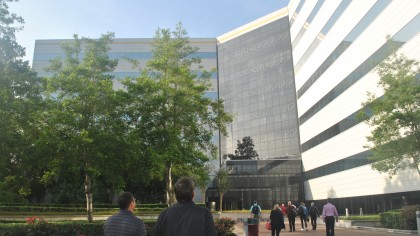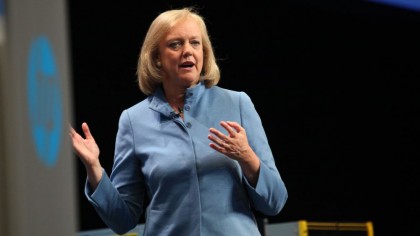What happened to HP?
A look back at a giant's decline

Remember when HP was a king amongst kings in the tech world? Your first laptop was probably an HP Pavilion. If you're old and wealthy enough, your first smartphone might have been an HP iPAQ. HP helped to pave the way for many of the devices we carry around today.
HP wasn't just a beacon for nerds. They made technology cool. Who can forget the intriguing collaboration between the computer manufacturer and rap icon Jay-Z in 2006?
For many, the HP brand elicits warm, fuzzy feelings of gleeful nostalgia. Kind of like Gateway.
Six years ago, the idea of Hewlett-Packard splitting up would have been ludicrous. Three years ago, it was the rumor de jour of the tech world. Today it's an ongoing reality.
Silicon Valley's original technology company is dividing in two as a part of the company's five-year plan to recover from years of disappointing quarterly reports. The company will be cleaved into two new companies, HP Inc. and Hewlett-Packard Enterprise, by the end of HP's 2015 fiscal year.
Like many mature companies with long histories, HP has had many ups and downs over the past 76 years. While it is impossible to definitely say that any single factor caused HP's decline, market forces, internal strife at the company and decisions (and indecisions) about acquisitions and potential spin-offs are among the factors that led HP to its current state and eventual split.

1999
The upcoming HP divide is not the first in the company's recent history. HP spun off its Medical Products and Instrument Group to form Agilent Technologies in 1999. The latter's Initial Public Offering (IPO) broke records for a Silicon Valley IPO by raising $2.1 billion during the dotcom bubble.
Sign up to the TechRadar Pro newsletter to get all the top news, opinion, features and guidance your business needs to succeed!
2002
HP acquired Compaq for $19 billion. The move is criticized throughout the technology markets as a potential mistake.
2005
After the bubble burst, HP was impacted by the resulting recession of the early 2000s. HP's stock lost about half its market value by the time the company's Board of Directors forced then CEO Carly Fiorina to resign in 2005. After about a month under an interim CEO, Mark Hurd took the helm as HP's CEO.
2010
Hurd remained in the CEO position for about half a decade. During that time, HP acquired Palm, providing the company with many patents and the webOS, a mobile operating system.
Five years of revenue gains and a hefty increase in stock growth over this period helped lead the technology firm into a brighter era. In the annual report for HP's 2009 fiscal year Hurd wrote, "Over the last five years, HP has become a much more agile company, able to adapt and benefit from changing market conditions. In fiscal 2009, we gained share in key markets and continued to invest for growth in research and development, acquisitions, and sales coverage."
But it did not last. Hurd was accused of sexual harassment. While he was cleared of wrongdoing for that accusation, Hurd was found to have submitted false expense reports to hide a relationship. Hurd's friend and now-former Oracle CEO Larry Ellison compared it to when Apple forced Steve Jobs to resign in an email sent to The New York Times.
Léo Apotheker, a European technology executive with experience in software companies, succeeded Hurd as CEO. Analysts lowered their forecasts for HP under his brief tenure of 11 months. The company's stock fell 47% during his time as CEO.
2011
During this period, the first inklings of a portion of HP splitting from the company occurred. The company's PC business was valuable enough to consider selling or splitting from the main company. Apotheker spoke about the potential spin-off, sending ripples through the market. Public knowledge of this indecision further hurt HP's brand (HP remains a big player in the PC market with about 17.4% of the market share in 2015's second quarter).
The HP TouchPad tablet floundered in a market dominated by Apple's iPad and was quickly discontinued less than two months after its launch when Apotheker announced that all webOS-based devices would be cut.
Also during this period, A New York Times story revealed that HP's board of directors was dealing with no shortage of internal strife. It also predicted that Apotheker's time as CEO would be short. The latter prediction was correct; HP's board fired Apotheker in September 2011 less than a year after being named CEO. Even before his firing, rumors swirled that former eBay CEO Meg Whitman would be named as Apotheker's replacement. A 2012 Fortune magazine story would later confirm some of the dysfunction and state that HP "had lost its way."

Meg Whitman was the next CEO to step up to HP. Whitman's resume includes her tenure as CEO of eBay during the dot-com bubble burst, helping bolster opinion that she would be able to help turn the struggling company around. Others worried that she would be another Apotheker since her primary experience was with e-commerce.
One of Whitman's first acts as CEO was to announce that HP will not splinter off its PC division, a move considered publicly by her predecessor.
2012
Whitman's five-year plan to turn around HP becomes public. Despite continuing declines, the company's debt reduction, improvements in cash flow and other balance-sheet improvements are seen in the annual report for the 2012 fiscal year.
Whitman's approach to reversing the company's fortunes is to introduce cloud-based products, reducing HP's workforce through layoffs and retirements and a new advertising campaign.
2013
HP launches HP Next, a vertical dedicated to providing the public with news about HP's progress. Many news releases, including the initial split and announcements about the leadership at HP Inc. and Hewlett-Packard Enterprise are available online there.
2014
HP announces that the company will be split into two separate companies, one focusing on printers and computers and the other on business software. Whitman tells the press and public that the split is part of her plan to save HP. The initial deadline for the split is the end of the company's 2015 fiscal year. CEO Whitman told The Wall Street Journal that HP's stronger financial position made the idea of splitting more attractive than it had been in 2011.
2015
HP's fiscal year begins November 1. A final quarterly report and a final annual report will be released shortly after this date, showing how HP's last quarter ends.
The two companies HP will form will be large enough to remain in the top half of the Fortune 500 list (HP is ranked at 19 in the latest edition and HP's last as the Hewlett Packard Co, a decline from the previous year's 17 rank.)
The goal is to create two companies "nimble" enough to thrive in the highly competitive technology market dominated by smartphones, apps and cloud computing.